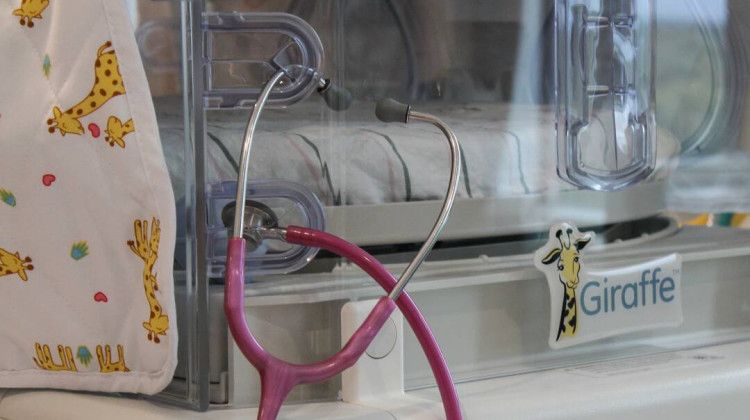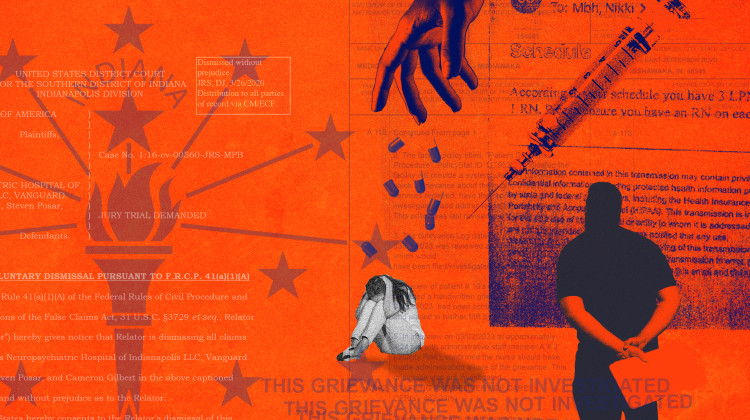
Kate Voss is the outreach coordinator for SENSE charter school. She helped secure a Safe Routes to School grant to encourage walking and biking among students.
Jake HarperINDIANAPOLIS -- On a hot day, some adults have taken a group of kids to explore the neighborhood around their school, SENSE — the Southeast Neighborhood School of Excellence, a K-8 charter school in Indianapolis. They’ve left the school’s air-conditioned cafeteria to perform a walk audit.
They’re looking for missing sidewalks and bike lanes, potholes, and other issues that may make it unsafe to walk to school. The theory is, if you identify and fix some of these obstacles, and kids might be more likely to walk or bike to school.
A few decades ago, almost half of all students in the U.S. walked or biked. According to a 2009 study, that number has dropped to to one in eight. Meanwhile, obesity has climbed, along with the health problems that go with it, such as diabetes and heart disease.
This is something some public health advocates are trying to change. “There definitely are schools where walking and biking is a viable option,” says Allan Henderson, Safe Routes to School program manager for the nonprofit Health By Design. Safe Routes to School uses federal funds to remove barriers to walking and biking.
Walking and biking to school could be a way to help combat obesity in kids, says Stephanie Thornberry, a chronic disease prevention specialist with the Marion County Public Health Department.
“When they get to be adults they’re less likely to have obesity and all the chronic diseases that go along with that,” she says.
The obesity epidemic is especially pronounced in Indianapolis, which has been named America’s least fit big city two years in a row by the the American College of Sports Medicine. Nearly a third of its citizens are obese, and few get regular exercise.
Henderson says one of the main barriers to walking to school is distance. Over the years, “we began to locate our homes further and further from schools,” he says. “They were not connected to the city center with sidewalks.” More and more kids took the bus.
Henderson says there are still areas where walking and biking are possible, but parents have other concerns, such as traffic. That’s why the group group from SENSE charter school was checking out the sidewalks and roads. But getting kids to walk is not just about adding crosswalks and speed limit signs.
“There also has to be some encouragement on the part of the school,” says Henderson.
SENSE is working on its walking rates thanks to a Safe Routes to School grant. The school did a tally and found that the vast majority of its students arrive by car or bus. Just one in ten walks.
“We found that there are no bikes,” says Kate Voss, the outreach coordinator at SENSE who is leading the school’s effort to improve the walking and biking rate. Voss has lived in the neighborhood for 16 years, and she thinks one serious barrier to walking is a fear of crime.
While they walk around, students notice abandoned houses and litter — things that reinforce the idea that this can be a rough place. “Whether it's true or not, they don't feel like they can be by themselves,” says Voss.
Worries over traffic and crime are issues that feed on themselves. The more cars dropping kids off, the more dangerous traffic appears. Fewer kids walking makes it seem more likely that something bad could happen to a child on the way to school.
So public health advocates like Henderson want to reverse that cycle. “The more students doing it, the safer it becomes, the more parents will allow their students to walk,” he says.
Kate Voss plans to hold walking and biking safety classes at the school, with raffles to bring people in. And after some bicycle repair training, a few kids will be getting free bikes. She thinks walking and biking would be good for the students, but she also hopes seeing more kids and parents walking around will have a ripple effect on the surrounding neighborhood.
“I never look at us as an island,” she says. “It's not just getting to school back and forth, but it's a sense of security for our families and for our community.”
Side Effects Public Media is a health reporting collaborative based at WFYI in Indianapolis. Jake Harper can be reached at 317-614-0482 or jharper@wfyi.org. Follow him on Twitter: @jkhrpr.
 DONATE
DONATE






 View More Articles
View More Articles

 Support WFYI. We can't do it without you.
Support WFYI. We can't do it without you.